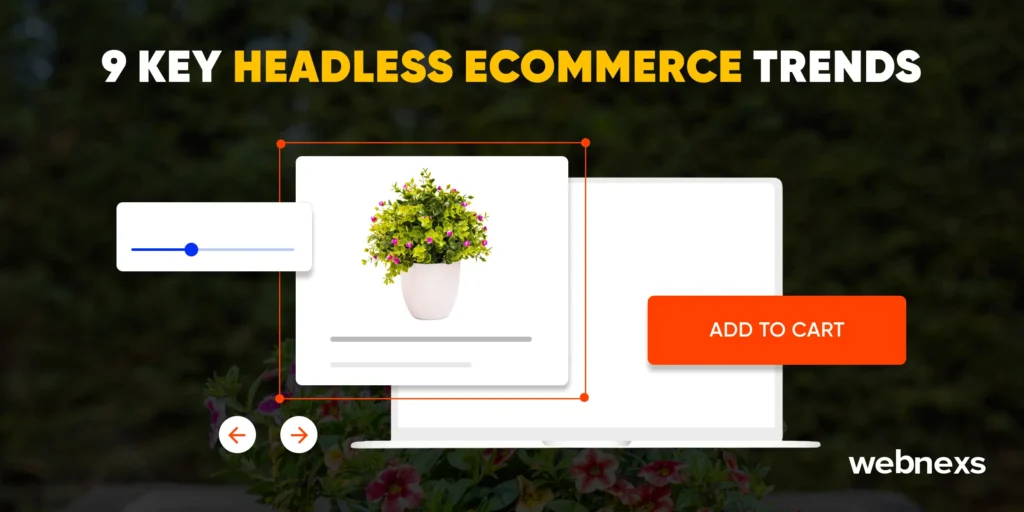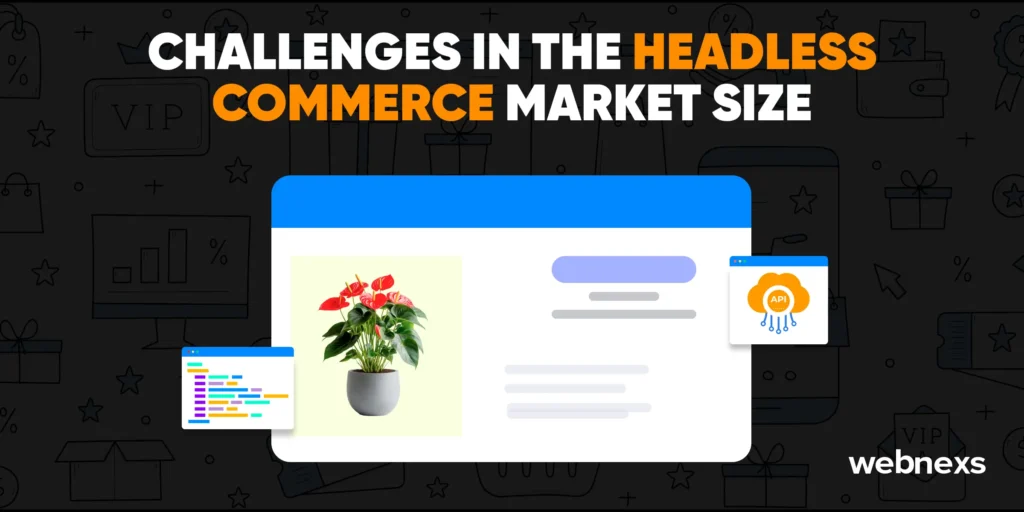Hi, Creative Explorers!
Global ecommerce sales are expected to reach $6.33 trillion in 2025 (source)
Online purchases accounting for 21% of all retail sales by 2026 (source).
As digital adoption accelerates, the industry is set for continued expansion (source).
A new analysis from PYMNTS highlights that the headless commerce statistics is projected to grow by over 25% annually through 2026, with global investments surpassing $1.2 billion by the end of the forecast period.
Wondering what’s next for headless commerce?
Check out our in-depth look at the latest headless commerce statistics and trends for 2025. Learn about the projected growth, industry shifts, and key developments shaping the future of this innovative approach to ecommerce.
Get the insights you need to stay ahead in the ever-changing world of headless commerce.
The headless commerce market size is growing fast and is expected to reach $32.1 billion by 2027, with an annual growth rate of 20.5%.
This shows that more ecommerce businesses are turning to headless commerce solutions. By the end of 2024, the global market is expected to grow to about $6.9 trillion, reflecting the rapid expansion of this industry.
According to Digital Commerce 360, almost half of the major online stores are expected to adopt headless commerce in the next two years. This indicates that the ecommerce industry is rapidly embracing the trend.
Experts predict significant market share growth in headless commerce by 2024. Headless commerce statistics show that more and more ecommerce companies are recognizing the benefits of this approach.
According to a survey by BigCommerce, 66% of ecommerce decision-makers intend to adopt a headless commerce strategy in the upcoming year.
Additionally, a survey by Commerce Layer found that 54% of ecommerce experts believe headless commerce is the future of ecommerce.
As demand grows for more flexible, scalable, and customizable ecommerce sites, experts predict that this will drive the continued growth of the headless commerce market size.
Key Takeaways on Headless Commerce Statistics
- Headless commerce statistics show the market is set to hit $32.1 billion by 2027, growing at 20.5% each year.
- Headless commerce statistics reveal that North America and Europe are in charge of adopting this new approach to ecommerce.
- More businesses are turning to headless commerce market size, as the model offers greater flexibility and helps scale their online stores more easily.
- Though there are integration challenges, headless commerce stats point to long-term benefits like faster site speeds and better customer experiences.
- Looking at the latest headless commerce stats now is a great time for businesses to consider making the switch to stay competitive.
Headless Commerce Statistics: Detailed Analysis of Headless Commerce Market Size 2025

According to MAJOR Digital, headless commerce market indicate that the market size was valued at $1.32 billion in 2020 and is expected to reach $13.08 billion by 2028, reflecting a remarkable CAGR of 30.1%
During the forecast period, the headless commerce statistics analysis expects North America to hold the largest market share
Moreover, the increasing number of online businesses and the high adoption rate of advanced ecommerce solutions in the region are driving the growth of the headless ecommerce market in North America.
This is why the headless commerce market size is expanding rapidly in the region.
We expect important growth in the headless commerce statistics market in Europe due to the increasing number of ecommerce businesses.
Experts expect that the headless ecommerce market will grow at a CAGR of 22.9% and reach USD 3.9 billion in revenue by 2025.
The online shopping industry is getting bigger because customers want experiences made just for them and new technologies are being used.
The analysis suggests that the headless commerce statistics market will experience significant growth due to flexible solutions and new technologies.
Scale New Heights with Headless Commerce Statistics
Additional Interesting on the Headless Commerce Stats
- According to headless commerce statistics, from 2021 to 2028: the headless commerce market will grow at a CAGR of 17.5% and reach a market size of $19.20 billion. (Source: Grand View Research)
- North America to hold the largest share of the headless commerce market from 2021-2028 due to key players and early adoption. (Source: Allied Market Research)
- The top benefits of headless commerce cited by retailers include faster site performance, greater flexibility, and improved customer experience. (Source: BigCommerce)
- Implementing headless commerce poses several main challenges, including integrating with existing systems, handling technical complexity, and incurring higher development costs. (Source: BigCommerce)
“Headless commerce stats show the growth potential, benefits, and challenges, indicating its emergence as a promising technology.”
9 Key Headless Commerce Trends: Drivers, Flexibility, and Future Growth

1. In-depth Analysis of Headless Ecommerce Market Drivers
Analyzing key factors provides insights into the headless ecommerce market’s growth.
The headless commerce market size is projected to reach $4.37 billion by 2025, growing at a compound annual growth rate (CAGR) of 18.8% from 2020 to 2025.
ZipDo
2. Perfect Timing for Ecommerce Platform Development
The current market conditions present an ideal opportunity to start or rebuild your ecommerce platform.
By 2022, headless commerce trends are projected to reach a market value of $12.63 billion, indicating a significant shift towards this architecture.
Worldmetrics
3. Need for Flexibility and Customization
Demand for more flexible and customizable ecommerce solutions is a key factor driving the market.
Separating frontend and backend enables businesses to experiment with new technologies and tools more easily.
62% of companies agree that headless ecommerce can significantly increase engagement and conversions, highlighting the demand for flexible and customizable solutions.
Crystallize
4. Flexibility in Ecommerce Development
Headless ecommerce allows businesses to adopt a more flexible approach to development.
77% of organizations with headless architecture report that it enables faster changes to storefronts, allowing businesses to adapt quickly to market trends.
Alokai
Read More: 6 Best Web Development Trends & Technologies
5. Importance of Personalized Customer Experience
Headless ecommerce plays a crucial role in delivering personalized customer experiences, which are increasingly important in a competitive market.
91% of customers are likelier to shop with brands that recognize, remember, and provide relevant offers and recommendations, which headless commerce platforms can effectively facilitate.
GraphQL Commerce
6. Adoption of New Technologies and Tools
The use of new technologies is a significant driver in the headless ecommerce market.
These technologies help businesses create and launch online shopping solutions faster and with less effort.
In the first quarter of 2024, startups in the headless commerce market experienced a 50% increase in venture capital investments compared to the same period in 2023, signaling strong investor confidence in the market’s expansion.
GraphQL Commerce
7. Evolving Business and Consumer Needs
Growth in the headless commerce market is influenced by how businesses and customers are evolving.
Companies can enhance online shops by using new technology to offer more personalized and adaptable options.
73% of businesses have implemented headless website architectures as of 2023, reflecting the evolving needs of businesses and consumers.
Netguru
8. Competitive Advantage and Revenue Growth
By adopting headless ecommerce, businesses can gain a competitive edge and attract more customers, leading to higher sales.
80% of businesses that have implemented headless commerce report an increase in revenue, demonstrating the competitive advantage and financial benefits of adopting this architecture.
ZipDo
9. Future of Online Shopping
As more people shop online, the trend will continue toward faster, more personalized shopping experiences tailored to individual needs.
Headless commerce market can be tough to implement due to technical challenges, but it offers great opportunities for customization and growth.
By 2025, ecommerce revenue is expected to surpass $6.8 trillion, with 21% of all global sales made online by an estimated 2.77 billion shoppers, underscoring the growing importance of efficient and personalized online shopping experiences that headless commerce can provide.
GraphQL Commerce
Challenges in the Headless Commerce Market Size

- Getting headless commerce software up and running can be challenging because it requires experts with technical skills and the ability to integrate various systems seamlessly.
- This method can create added complexity and result in increased maintenance expenses.
- To effectively deal with these challenges, businesses need to implement new strategies and adopt best practices to stay on track.
Headless commerce requires skilled developers, with 64% of businesses facing API complexities. Costs are 30-50% higher, and 57% struggle with backend integrations and ongoing maintenance.
Read More: Growth of Artificial Intelligence in Ecommerce Business 2024
Opportunities Based On Headless Commerce Statistics

- Headless commerce lets businesses provide personalized shopping experiences across different platforms.
- It gives companies the flexibility and scalability to grow and adapt to changing needs.
- Using API-first platforms, businesses can leverage tools like data analytics and AI to improve customer satisfaction.
- It encourages innovation and offers better ways to improve the customer journey.
- Companies can explore new solutions to common challenges in online selling, staying competitive in the market.
80% of brands using headless commerce see higher revenue, with 24% sales growth. 91% of shoppers prefer personalized experiences, and API-first solutions boost customer retention by 33%.
Final thoughts
Headless commerce market size is growing quickly and is expected to reach $32.1 billion by 2027, with an annual growth rate of 20.5%.
According to headless commerce statistics, more businesses are choosing headless commerce solutions to offer flexible, scalable, and personalized ecommerce experiences.
North America and Europe are leading this trend, thanks to advanced technologies and higher adoption rates.
Switching to headless commerce market might come with some challenges, like managing integrations, but the benefits of faster website speed and better customer experiences make it a worthwhile choice.
This is a great time to take the leap and get your business ready for the future. Reach out to us today to see how we can help you make the move to headless commerce and stay ahead of the competition!

